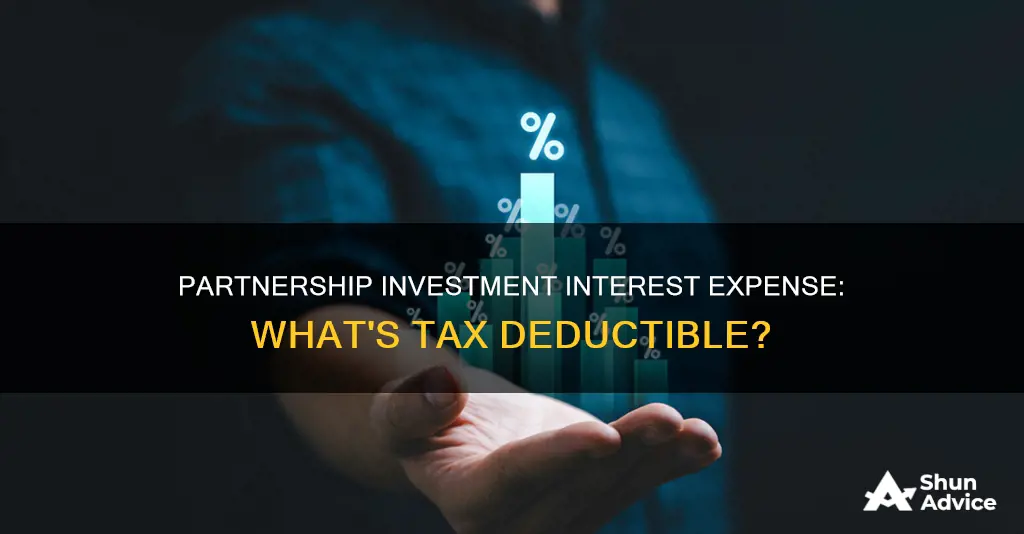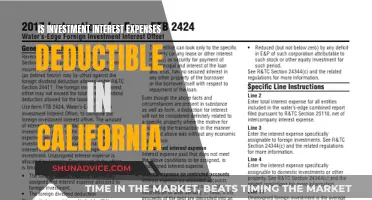
The interest expense incurred by a partnership's trading activity is subject to the investment interest limitation of Sec. 163(d). This is because the partnership's activity of trading securities involves the conduct of a trade or business, which is not a passive activity. The interest expense is reported as a nonpassive ordinary business loss on Schedule E.
| Characteristics | Values |
|---|---|
| Tax treatment | Subject to the investment interest limitation of Sec. 163(d)(1) if the limited partner does not materially participate in the trading activity |
| Allowable deduction | Reported as a nonpassive ordinary business loss on Schedule E |
| Taxpayer's investment interest expense | Must be accounted for separately using a pro-rata or some other reasonable method |
| Partnership's activity of trading securities | Conduct of a trade or business, which is not a passive activity |
| LP's interest in the partnership's trading activity | An interest in an activity that is property held for investment under Sec. 163(d)(5)(A)(ii.) |
| Partnership's trading business | Interest expense must be stated separately because the deductibility of the expense could be limited by the degree of participation by each partner |
| Hedge funds | Private investment partnerships that seek to maximise returns through active portfolio management rather than long-term capital appreciation |
| Typical hedge fund Schedule K-1 | Discloses that the partnership's trading activities constitute a trade or business, and the distributive share items are not considered to be derived from a passive activity under Temp. Regs. Sec. 1.469-1T(e)(6.) |
What You'll Learn
- The IRS has confirmed the proper tax treatment of a noncorporate limited partner's distributive share of interest expense on debt allocable to a partnership's trade or business of trading securities
- The partnership's activity of trading securities involves the conduct of a trade or business, which is not a passive activity
- Hedge funds are private investment partnerships that seek to maximise returns through active portfolio management rather than long-term capital appreciation
- The IRS revisited the issue in 2008 with the release of Rev. Rul. 2008-12 on March 10 and the concurrent release of Announcement 2008-65 and Rev. Rul. 2008-38 on July 3
- LP is a noncorporate limited partner who does not materially participate in the partnership's trading activity

The IRS has confirmed the proper tax treatment of a noncorporate limited partner's distributive share of interest expense on debt allocable to a partnership's trade or business of trading securities
The issue posed in Rev. Rul. 2008-12 is whether a noncorporate limited partner's distributive share of interest expense incurred in the trade or business of trading securities by the partnership is subject to the Sec. 163(d) limitation on the deduction of investment interest. The ruling confirms that it is.
The degree of participation by each noncorporate partner could limit the deductibility of the interest expense allocable to its trading business. Therefore, the partnership must separately state this expense.
Investing: My Journey and Interest Explained
You may want to see also

The partnership's activity of trading securities involves the conduct of a trade or business, which is not a passive activity
The IRS has confirmed the proper tax treatment of a noncorporate limited partner's distributive share of interest expense on debt allocable to a partnership's trade or business of trading securities for its own account. The interest expense is subject to the investment interest limitation of Sec. 163(d)(1) if the limited partner does not materially participate in the trading activity.
Hedge funds are private investment partnerships that seek to maximize returns through active portfolio management rather than long-term capital appreciation. Their activities go beyond mere investing and constitute trading. The typical hedge fund Schedule K-1 discloses that the partnership's trading activities constitute a trade or business, and the distributive share items are not considered to be derived from a passive activity under Temp. Regs. Sec. 1.469-1T(e)(6).
The K-1 will also instruct partners who do not materially participate in the partnership that the interest expense attributable to the partnership's trading activities is subject to the Sec. 163(d) investment interest limitation, and the allowable ordinary loss should be reported as nonpassive on Schedule E, Part II.
Investing Wisely: Navigating Rising Interest Rates
You may want to see also

Hedge funds are private investment partnerships that seek to maximise returns through active portfolio management rather than long-term capital appreciation
Hedge funds are limited partnerships of private investors whose money is pooled and managed by professional fund managers. These fund managers use a wide range of strategies, including leverage (borrowed money) and the trading of nontraditional assets, to earn above-average investment returns.
The typical hedge fund Schedule K-1 discloses that the partnership's trading activities constitute a trade or business, and the distributive share items are not considered to be derived from a passive activity. The K-1 will also instruct partners who do not materially participate in the partnership that the interest expense attributable to the partnership's trading activities is subject to the investment interest limitation.
The IRS has confirmed the proper tax treatment of a noncorporate limited partner's distributive share of interest expense on debt allocable to a partnership's trade or business of trading securities for its own account. The interest expense is subject to the investment interest limitation if the limited partner does not materially participate in the trading activity.
Understanding Investment Interest Expense: What Investors Need to Know
You may want to see also

The IRS revisited the issue in 2008 with the release of Rev. Rul. 2008-12 on March 10 and the concurrent release of Announcement 2008-65 and Rev. Rul. 2008-38 on July 3
Rev. Rul. 2008-12, released on March 10, 2008, addresses the insurance excise tax consequences of insurance premiums paid by one foreign insurer to another. Specifically, it clarifies the tax implications when the foreign insurer is eligible for an excise tax waiver by income tax treaty, but the foreign reinsurer is not. This ruling amplifies and clarifies Rev. Rul. 58-612, which addressed the applicability of reinsurance excise tax on premiums paid between foreign insurers and reinsurers.
Announcement 2008-65, released concurrently with Rev. Rul. 2008-12, provides procedures for manufacturers to certify that their fuel cell motor vehicles meet the requirements for a tax credit under section 30B(a)(1) and (b) of the Internal Revenue Code. It also addresses a transaction where a tax-indifferent party contributes distressed assets to a trust, and a US taxpayer acquires an interest in the trust to shift a built-in loss without incurring economic loss.
Rev. Rul. 2008-38, released on July 3, 2008, modifies and supersedes previous rulings (Rev. Ruls. 89-42, 97-31, and 2001-48). It provides guidance on the allowable amount of a limited partner's distributive share of a trading partnership's interest expense. This ruling ensures that partners correctly compute their ordinary business income or loss on Schedule E of their Form 1040.
Budget Surplus Impact: Interest Rates and Investments
You may want to see also

LP is a noncorporate limited partner who does not materially participate in the partnership's trading activity
The IRS has confirmed the proper tax treatment of a noncorporate limited partner's distributive share of interest expense on debt allocable to a partnership's trade or business of trading securities for its own account. The interest expense is subject to the investment interest limitation of Sec. 163(d)(1) if the limited partner does not materially participate in the trading activity.
The partnership's activity of trading securities involves the conduct of a trade or business, which is not a passive activity. Because LP does not materially participate in the partnership's trading business, LP's interest in the partnership's trading activity is an interest in an activity that is property held for investment under Sec. 163(d)(5)(A)(ii).
The typical hedge fund Schedule K-1 discloses that the partnership's trading activities constitute a trade or business, and the distributive share items are not considered to be derived from a passive activity under Temp. Regs. Sec. 1.469-1T(e)(6). The K-1 will also instruct partners who do not materially participate in the partnership that the interest expense attributable to the partnership's trading activities is subject to the Sec. 163(d) investment interest limitation.
Invest Wisely: Strategies for the Uninterested
You may want to see also
Frequently asked questions
The IRS has confirmed the proper tax treatment of a noncorporate limited partner's distributive share of interest expense on debt allocable to a partnership's trade or business of trading securities for its own account. The interest expense is subject to the investment interest limitation of Sec. 163(d)(1) if the limited partner does not materially participate in the trading activity.
A passive activity is one in which the partner does not materially participate, while a non-passive activity is one in which the partner is actively involved.
For an individual taxpayer, the allowable deduction is reported as a nonpassive ordinary business loss on Schedule E.
The interest expense attributable to the partnership's trading activities is subject to the Sec. 163(d) investment interest limitation, and the allowable ordinary loss should be reported as nonpassive on Schedule E, Part II.
The issue is whether a noncorporate limited partner's distributive share of interest expense incurred in the trade or business of trading securities by the partnership is subject to the Sec. 163(d) limitation on the deduction of investment interest.







